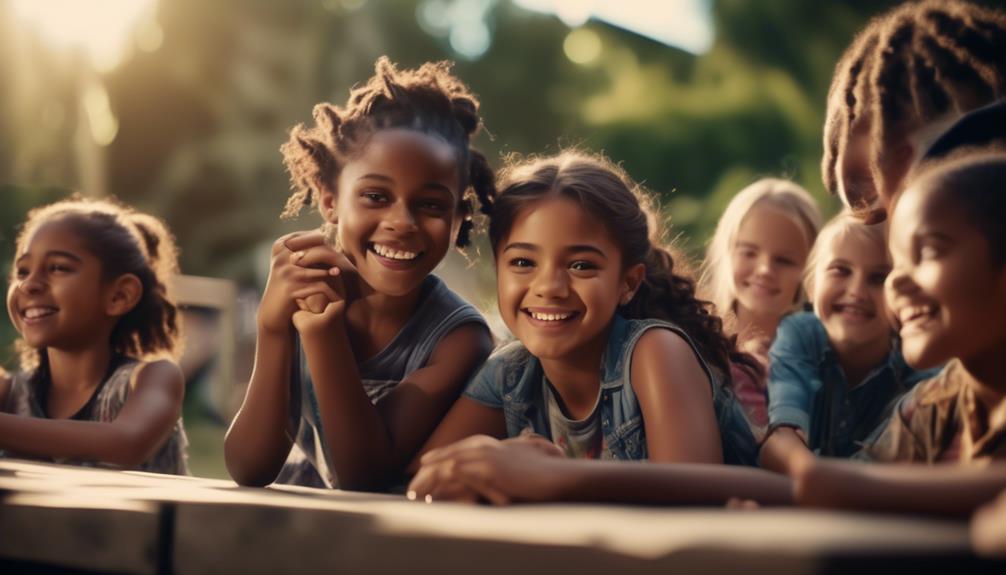How to Encourage Positive Peer Interactions to Reinforce Good Behavior

Encouraging positive peer interactions to reinforce good behavior involves several strategies.
One important aspect is fostering a harmonious classroom culture. This can be done by setting clear expectations for behavior and creating a safe and welcoming environment where students feel comfortable interacting with their peers.
Teaching effective communication skills is another key component. Students need to learn how to express their thoughts and feelings in a respectful manner, as well as how to actively listen to others.
Promoting collaboration is also essential. Encouraging students to work together on projects and assignments not only helps them develop important teamwork skills, but also provides opportunities for positive peer interactions.
Utilizing positive reinforcement, empathy, and peer feedback is another effective approach. Recognizing and rewarding good behavior can motivate students to continue behaving positively. Additionally, teaching empathy helps students understand and appreciate others' perspectives, leading to more respectful interactions. Lastly, allowing students to provide feedback to their peers can promote a sense of community and help them learn from each other.
Establish Clear Behavior Expectations
To foster positive peer interactions, it's imperative that clear behavior expectations are established. By establishing boundaries and behavior guidelines, we create an environment that promotes respect, empathy, and collaboration among peers. When expectations are clearly defined, individuals understand what's expected of them and can navigate social interactions with confidence and ease.
Setting boundaries is essential in creating a safe and inclusive space for all. By establishing clear boundaries, we communicate what behaviors are acceptable and what'll not be tolerated. This helps prevent misunderstandings and conflicts, allowing individuals to engage in healthy and respectful interactions.
Behavior guidelines serve as a roadmap for proper conduct. They provide a framework for individuals to follow, guiding their actions and promoting positive behavior. These guidelines should be communicated effectively, ensuring that everyone understands their role in creating a harmonious environment.
In establishing these expectations, it's important to involve the entire community. By collectively deciding on behavior expectations, individuals feel a sense of ownership and responsibility, leading to a stronger commitment to upholding these standards.
Foster a Positive and Inclusive Classroom Culture
Creating a positive and inclusive classroom culture is essential for fostering a nurturing and empowering learning environment. By promoting an inclusive classroom, you create a space where every student feels valued, respected, and accepted for who they are. This not only enhances their overall well-being but also encourages positive peer interactions and better behavior.
One way to foster an inclusive classroom is through positive reinforcement. This involves acknowledging and rewarding students' positive behavior, which helps create a supportive and encouraging atmosphere. Implementing a table that highlights positive behaviors and corresponding rewards can be an effective tool in promoting positive peer interactions.
| Positive Behaviors | Rewards |
|---|---|
| Actively participating in class discussions | Verbal praise and recognition |
| Demonstrating kindness towards classmates | Extra free time or privileges |
| Helping others with their schoolwork | Special certificates or awards |
| Respecting diversity and treating everyone with kindness | Small tokens of appreciation |
Teach and Model Effective Communication Skills
As you embark upon the journey of teaching and modeling effective communication skills, you'll find yourself guiding your students towards clear and respectful communication.
Encourage them to express their thoughts and emotions in a way that fosters understanding and empathy, ensuring that they listen actively to one another.
Emphasize the importance of nonverbal cues, for they can often convey messages that words alone cannot.
Clear and Respectful Communication
How can you effectively teach and model clear and respectful communication skills to encourage positive peer interactions?
By providing effective feedback and teaching conflict resolution techniques, you can guide others towards open and honest communication.
Encourage active listening, where individuals truly listen to understand, rather than simply waiting for their turn to speak.
Teach the importance of empathy, helping individuals understand and appreciate differing perspectives.
Model respectful language and tone, showing others how to express their thoughts and feelings without resorting to aggression or disrespect.
Create opportunities for role-playing, where individuals can practice using effective communication skills in a safe and supportive environment.
By consistently demonstrating and reinforcing these skills, you can empower others to communicate in ways that foster positive interactions and build strong relationships.
Active Listening Skills
To effectively teach and model clear and respectful communication skills, you must embody the art of active listening, allowing others to feel truly heard and understood. Active listening is a powerful tool that can enhance your interactions and deepen your relationships with those around you.
Here are three key techniques to incorporate into your communication strategies:
- Maintain eye contact: By looking directly at the person speaking, you show them that you're fully present and engaged in the conversation. This simple act communicates your sincere interest in what they've to say.
- Practice empathy: Put yourself in the other person's shoes and try to understand their perspective. This requires setting aside your own judgments and biases, and truly listening with an open mind and heart.
- Provide verbal and non-verbal cues: Nodding your head, smiling, and making supportive comments can encourage the speaker to continue sharing. Additionally, summarizing or paraphrasing what they've said shows that you're actively listening and seeking to comprehend their message.
Nonverbal Communication Importance
Nonverbal communication plays a crucial role in teaching and modeling effective communication skills, allowing individuals to express themselves authentically and deeply connect with others. Nonverbal cues and body language are powerful means of communication that can convey emotions, intentions, and attitudes without using words.
These subtle yet significant signals have the potential to enhance and enrich our interactions with others. They can help us understand and interpret the true meaning behind someone's words, fostering empathy and understanding. By incorporating nonverbal cues into our communication, we can create a more harmonious and meaningful exchange with our peers.
Whether it's a warm smile, a gentle touch, or maintaining eye contact, these nonverbal expressions can strengthen the bonds we share and promote positive peer interactions. Let's remember the importance of nonverbal communication and harness its power to uplift and inspire others.
Encourage Collaboration and Teamwork
As you embark on the journey of fostering positive peer interactions, one key aspect to focus on is encouraging collaboration and teamwork.
Group projects serve as a powerful tool to enhance collaboration among students, as they learn to work together towards a common goal.
By fostering a cooperative environment, where students support and rely on one another, you create a space that nurtures teamwork and cultivates essential skills for success in both academic and real-world settings.
Engaging students in activities that require collaboration further reinforces the importance of teamwork, allowing them to develop invaluable skills that will benefit them throughout their lives.
Group Projects Enhance Collaboration
Group projects, with their emphasis on collaboration and teamwork, foster an environment where students can cultivate essential interpersonal skills and collectively achieve remarkable outcomes. Engaging in collaborative learning allows individuals to pool their unique perspectives, knowledge, and expertise, leading to a more comprehensive understanding of the subject matter.
When students come together to solve problems as a team, they learn the importance of effective communication, active listening, and compromise. Through group projects, students also develop crucial skills such as leadership, delegation, and conflict resolution, all of which are essential in real-world scenarios.
Furthermore, working in a group promotes a sense of belonging and encourages students to value and respect diverse opinions and backgrounds. Ultimately, group projects serve as a platform for students to learn, grow, and thrive together, fostering a culture of collaboration and teamwork.
Foster a Cooperative Environment
Creating a cooperative environment is crucial in fostering collaboration and teamwork among students. By promoting cooperative learning and team building, you can cultivate an atmosphere where students thrive on mutual support and shared goals.
Encourage students to work in pairs or small groups, providing opportunities for them to collaborate on tasks and projects. This not only enhances their understanding of the subject matter but also develops their interpersonal skills.
Foster a sense of unity and shared responsibility by assigning group projects that require students to work together and contribute their unique strengths. Encourage open communication, active listening, and the valuing of diverse perspectives.
Promote Teamwork Through Activities
To further cultivate collaboration and teamwork among students, foster a spirit of camaraderie and shared achievement through engaging activities that encourage active collaboration and the development of interpersonal skills. Team building exercises and collaborative projects provide valuable opportunities for students to work together towards a common goal, fostering a sense of unity and cooperation.
Here are three effective approaches to promote teamwork through activities:
- Problem-solving challenges: Engage students in tasks that require them to work together to find creative solutions. This encourages them to communicate, listen to each other's ideas, and collaborate effectively.
- Group projects: Assign projects that require students to collaborate and divide tasks. Encourage them to share responsibilities, communicate, and support one another to achieve success as a team.
- Cooperative games: Introduce games that rely on teamwork and cooperation. These activities promote trust-building, effective communication, and the understanding that success is achieved through collective effort.
Implement Cooperative Learning Activities
Implementing cooperative learning activities can foster a harmonious and collaborative learning environment, where students actively engage with their peers to enhance their understanding and skills. The benefits of cooperative learning are numerous and impactful.
When students work together in groups, they have the opportunity to develop crucial social and emotional skills such as communication, empathy, and teamwork. This not only enhances their academic performance but also prepares them for future endeavors where collaboration is key.
Cooperative learning activities also promote effective group work. By working in teams, students learn to value and respect each other's contributions, creating an inclusive and supportive atmosphere. They learn to actively listen to their peers, appreciate diverse perspectives, and build on each other's ideas. This synergy leads to deeper learning and a sense of shared accomplishment.
Furthermore, cooperative learning activities encourage active participation from all students, helping to reduce the achievement gap and increase equity in the classroom. By providing opportunities for students to work together, teachers can tap into their collective intelligence and create a dynamic learning experience that benefits everyone involved.
Incorporating cooperative learning activities into your teaching repertoire won't only reinforce good behavior but also nurture a sense of community and collaboration among your students. By fostering positive peer interactions through cooperative learning, you are empowering your students to become lifelong learners who understand the value of working together for the greater good.
Use Positive Reinforcement Strategies
Positive reinforcement strategies are a powerful tool for cultivating an encouraging and uplifting classroom environment. By implementing these techniques, you can effectively reinforce good behavior and foster a positive atmosphere for learning and growth. Here are three behavior modification strategies that utilize positive reinforcement:
- Verbal praise: Offering genuine and specific words of encouragement can go a long way in reinforcing positive behavior. By acknowledging and highlighting the efforts and achievements of your students, you inspire them to continue striving for excellence.
- Rewards and incentives: Providing tangible rewards or incentives can serve as a powerful motivator for students. Whether it's stickers, small prizes, or extra privileges, these rewards can create a sense of excitement and encourage students to consistently demonstrate positive behavior.
- Behavior charts and tokens: Creating visual representations of progress, such as behavior charts or token systems, can help students track their own growth and achievements. By allowing them to earn tokens or move up on the behavior chart, you provide a concrete and tangible way for them to see the positive effects of their actions.
Promote Empathy and Understanding
Encouraging empathy and understanding among your students is a fundamental aspect of fostering a harmonious and inclusive classroom environment. By developing empathy, students can better understand and relate to the experiences and emotions of others. Fostering understanding allows them to appreciate the diverse perspectives and backgrounds within the classroom.
To promote empathy and understanding, you can incorporate various strategies into your teaching approach. One effective method is to engage students in meaningful discussions that encourage them to consider different viewpoints. By creating a safe space for open dialogue, you empower students to express their thoughts and listen to others respectfully. This can broaden their understanding of different perspectives and cultivate empathy towards their peers.
Another way to promote empathy is through storytelling. Sharing stories that highlight diverse experiences and emotions can help students develop a deeper sense of empathy. Encourage students to put themselves in the shoes of the characters and reflect on their feelings and motivations. This practice nurtures compassion and understanding, fostering a classroom environment where students actively support and uplift one another.
To further engage your students, let us explore a table that showcases practical strategies to promote empathy and understanding:
| Strategies | Benefits |
|---|---|
| Engage in meaningful discussions | Encourages diverse perspectives |
| Share stories and promote reflection | Develops compassion and empathy |
| Encourage active listening | Fosters understanding and respect |
| Promote cooperative activities | Builds teamwork and empathy |
Implementing these strategies will not only enhance your students' social-emotional development but also create a classroom culture that values empathy, understanding, and compassionate service towards others. Remember, by fostering empathy and understanding, you are not only shaping students' character but also equipping them with essential skills for a harmonious and inclusive future.
Provide Opportunities for Peer Feedback and Reflection
Create a space that fosters growth and self-reflection by providing opportunities for peer feedback and reflection. Peer reflection is a powerful tool that allows individuals to gain new insights and perspectives about themselves and their actions. By encouraging feedback opportunities among peers, you cultivate an environment that promotes personal growth and accountability.
Here are three ways you can provide such opportunities:
- Peer feedback sessions: Organize regular sessions where individuals can openly share their observations, concerns, and suggestions with their peers. This allows for constructive feedback and promotes self-awareness, as individuals learn from each other's experiences and perspectives.
- Reflection exercises: Provide prompts or questions that encourage individuals to reflect on their behaviors, choices, and interactions. These exercises can be done individually or in small groups, allowing participants to deepen their understanding of themselves and their impact on others.
- Collaborative projects: Assign collaborative projects that require individuals to work together towards a common goal. This not only fosters teamwork and cooperation but also provides a natural platform for peer feedback. Encourage individuals to provide constructive feedback to their peers, highlighting strengths and areas for improvement.
Frequently Asked Questions
How Can I Address Specific Behavior Issues With Individual Students?
To address behavior issues with individual students, consider implementing strategies and interventions tailored to their specific needs. By doing so, you can effectively guide them towards positive peer interactions and reinforce good behavior.
What Can I Do if a Student Is Consistently Not Participating in Group Activities?
If a student consistently does not participate in group activities, try implementing strategies to motivate them. Encourage their involvement by assigning roles, providing incentives, or creating a supportive environment where they feel comfortable contributing.
How Do I Handle Conflicts Between Students During Cooperative Learning Activities?
To handle conflicts during cooperative learning, employ conflict resolution strategies. Encourage open communication, active listening, and empathy. Foster teamwork by promoting inclusivity, collaboration, and appreciation for diverse perspectives. Create a safe and respectful environment for positive peer interactions to flourish.
What Are Some Effective Ways to Teach Empathy and Understanding to Students?
To teach empathy and understanding, engage students in role-playing activities that allow them to step into others' shoes. Encourage community projects that foster a sense of unity and compassion. By doing so, you empower them to become compassionate and empathetic individuals.
How Can I Involve Parents in Promoting Positive Peer Interactions Outside of the Classroom?
To involve parents in promoting positive peer interactions outside of the classroom, encourage open communication, organize community events, and provide resources for parents to support their child's social development. Together, we can create a strong network of support for our children.










